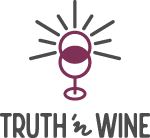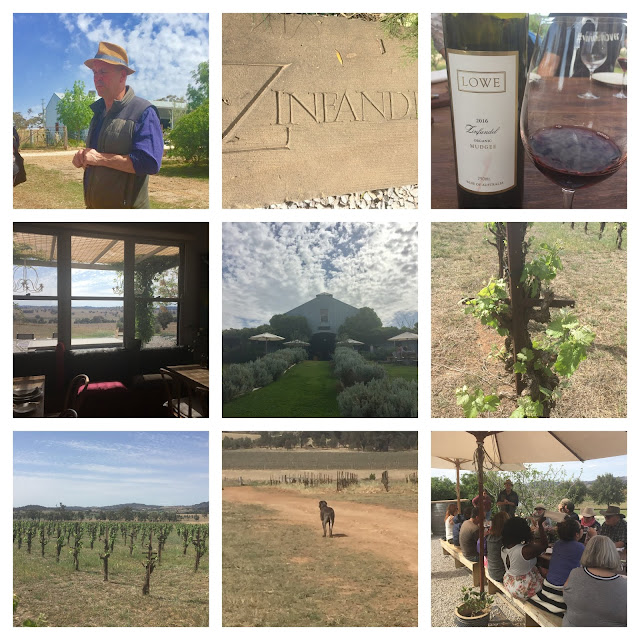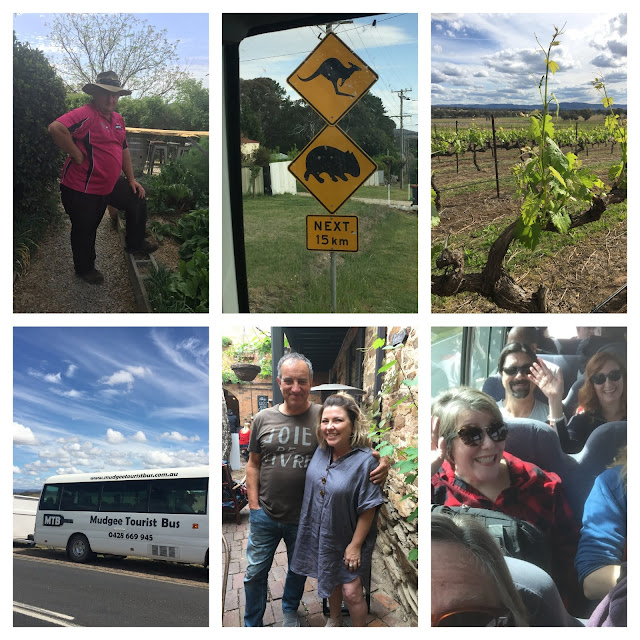In my first post on Mudgee, I focused on Day 1 of my excursion with the Wine Media Conference to this gorgeous wine region and town. On Day 2, I visited several more wineries, and below are my notes on each.
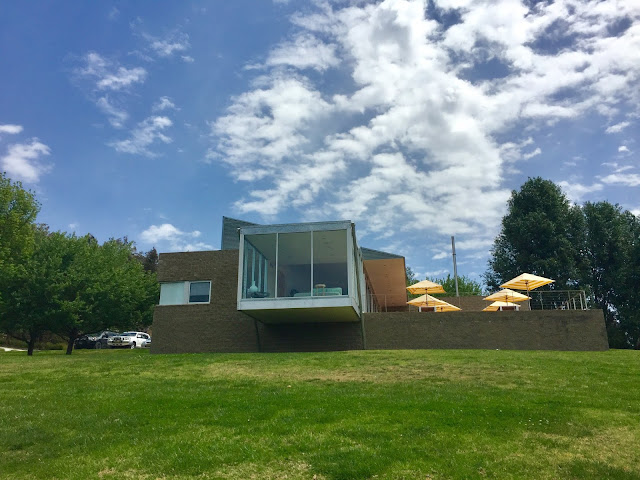 |
| Logan Vineyard’s unique winery and tasting room |
Logan Wines
Logan’s wines are a beautiful melding of new world pizazz and old world finesse. My husband and I were especially impressed with the Weemale Tempranillo. The Ridge of Tears shiraz (pictured below) is Logan’s homage to his Scottish ancestors, using Shiraz grapes from Mudgee and Orange, grown on the best slopes, with low yields and produced with “hand-made” loving care to create Logan’s signature style. This Shiraz is beautiful.
This winery is well worth visiting if you find yourself in Mudgee.
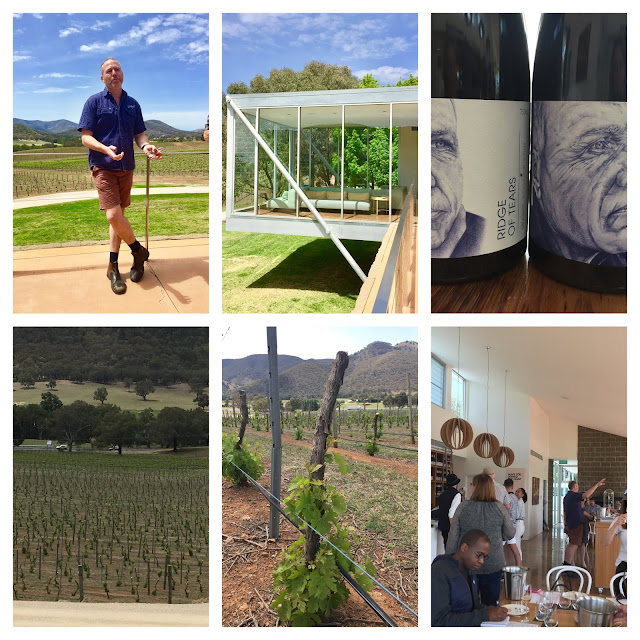 |
| (Top left, clockwise) Winemaker Peter Logan; Logan’s posh tasting room; Ridge of Tears Shiraz; Merlot vines waiting for grafting with Tempranillo; inside the tasting room. |
Moothi Estate
| Moothi’s 180-degree view cannot be beat. |
Moothi Estate is a family-owned winery, founded in 1995, nestled in the Mudgee hills, and it’s delightful. Moothi is another Aboriginal word for “nest in the hills.”
The tasting room and outside terrace are a perfect setting for a long, languorous lunch and wine tasting. The winery’s cellar door/kitchen features small bites and charcuterie platters (see picture below), and spectacular views. And the owners are lovely … as welcoming as can be. They generously poured for us just about everything on their menu, which started with sparkling rose, and moved through Riesling, Pinot Grigio, Viognier, Chardonnay, Merlot, Cabernet Sauvignon, a Cabernet-Shiraz-Merlot red blend called Mooth Rocks, a Shiraz-Viognier blend, and a fortified Shiraz.
All of Moothi’s grapes are estate grown, and the cellar door, one of the highest in the region, overlooks the vines.
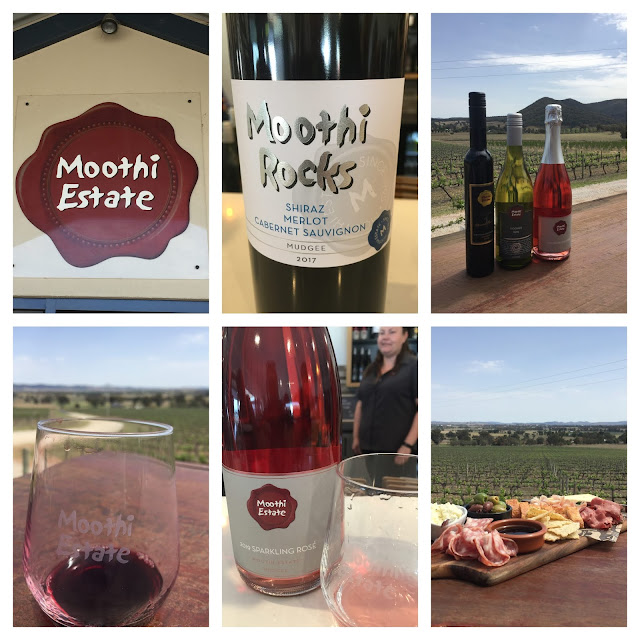 |
| (Upper left, clockwise) Moothi’s logo; Moothi Rocks Red Blend; wines on deck; delicious charcuterie platter from Moothi’s kitchen |
Burnbrae Wines
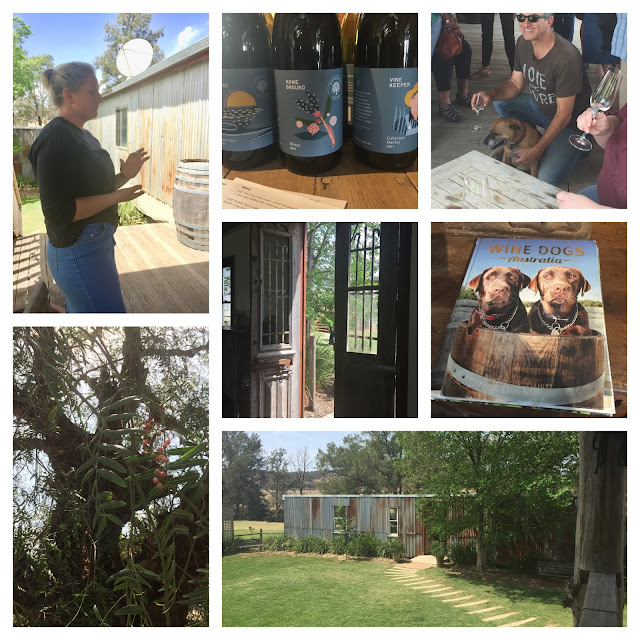 |
| (Top left, clockwise: Owner Trine Gay; “book cover” labels; my husband Bruce with winery dog; cellar door reading; outbuilding for events; peppercorn tree; charming rustic doors (center). |
Burnbrae produces a range of wines, including the above-mentioned sparkling white, Sauvignon Blanc, Pinot Noir (my favorite), Shiraz, Cab-Merlot blend, Pinot Gris, and a couple of different Rose wines, which are slightly spritzed and sweet, using the Moscato grape. The lineup is definitely youth-oriented, light, and fun.
Lowe Wine & Zin House
This place is special in that it’s a winery, a restaurant, a wedding venue, and surprisingly, it’s also all about Zinfandel. My first thought was ‘Zin is quintessentially Californian … not Australian!’ I was definitely intrigued.
Our first stop was at Zin House, the restaurant, where we were treated to a gorgeous lunch prepared by Chef Kim Currie, wife of Lowe Wines‘ David Lowe. Served family style, in the gorgeous dining room that felt like an old farmhouse, the food was classy but not pretentious (see photos below). The foods were paired with Lowe’s lip-smacking wines. I was overwhelmed by the generosity of our hosts.
For the last four years, Zin House has been awarded One Chef Hat from the SMH Good Food Guide Awards, which, as explained to us, is Australia’s equivalent of Michelin stars. Very impressive.
Along with our lunch at Pipeclay Pumphouse at Robert Stein Winery, we were definitely eating in style on this Mudgee excursion, and Mudgee was living up to its reputation as a foodie destination.
 |
| The fare at Zin House, a One Chef Hat award-winning restaurant in Mudgee. |
Most of the produce used at Zin House is sourced right from the property, and is organic, as are the wine grapes from the estate vineyards. Like the best Zin vines in California, the vines are old, bush trained and untrellised, unirrigated, low-yielding, and in this case organic (certified) and biodynamic. Robert Lowe is passionate about his winemaking, calling it “slow winemaking,” which I interpret as quality. His wines are lovely, and who knew you could get great Zin in Australia?
Lowe is a fifth-generation Mudgee, descended from the first English settlers in the Valley. He has been in the wine business since birth, basically. He’s passionate about Zin, after having spent time in northern California, in his “formative years,” learning from California wine pioneers, and he also worked alongside Australian legends Len Evans and Murray Tyrrell. He seems to have wine running through his veins, and he’s also humble and approachable. I so enjoyed my conversations with him at his winery.
Final Thoughts on Mudgee
Special Thanks
I want to say a giant Thank You to Mudgee and its people. Also, cheers to the following organizations and business who welcomed Wine Media Conference 2019 attendees:
Mudgee Wine and Country Tours: https://mudgeewinetours.com.au/ Ben, our driver, was the best driver a visitor could ask for, making sure we saw wildlife, stunning vistas, and historic markers, even if it meant pulling to the side of the road spontaneously to shoot a picture of a road sign!
Cara George, CEO of Visit Mudgee Region: https://www.visitmudgeeregion.com.au/partner-services/meet-our-team/cara-george. A wonderful human being and great host, who made sure we stayed on schedule but also gave us the time we needed at each stop on our tour.
My fellow Wine Media Conference attendees who made the Mudgee excursion extra fun. It was great sharing the wine geek moments with all of you.
